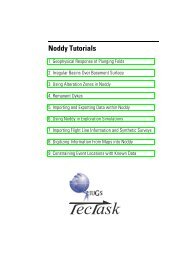Revised Eburnean geodynamic evolution of the ... - Tectonique.net
Revised Eburnean geodynamic evolution of the ... - Tectonique.net
Revised Eburnean geodynamic evolution of the ... - Tectonique.net
You also want an ePaper? Increase the reach of your titles
YUMPU automatically turns print PDFs into web optimized ePapers that Google loves.
Gravity anomalies are dominantly controlled by <strong>the</strong> distribution<br />
<strong>of</strong> <strong>the</strong> relatively dense metavolcanic group (Sefwi Group) and <strong>the</strong><br />
less dense metasedimentary groups (Kumasi and Tarkwa groups).<br />
The small differences between <strong>the</strong> observed and modelled gravity<br />
anomalies are difficult to determine given <strong>the</strong> model resolution is<br />
higher than <strong>the</strong> gravity data.<br />
5. Discussion<br />
5.1. Eoeburnean phase (2187–2158 Ma)<br />
Paleoproterozoic rocks <strong>of</strong> <strong>the</strong> sou<strong>the</strong>rn Ashanti Belt were<br />
strongly deformed, mineralised and intruded by granitoids during<br />
<strong>the</strong> “<strong>Eburnean</strong> Orogeny” (Fig. 17). Previous interpretations <strong>of</strong> <strong>the</strong><br />
regional tectonic <strong>evolution</strong> (e.g. Allibone et al., 2002a; Feybesse<br />
S. Perrouty et al. / Precambrian Research 204– 205 (2012) 12– 39 35<br />
Fig. 16. (Continued)<br />
et al., 2006) suggest <strong>the</strong> <strong>Eburnean</strong> Orogeny initiated during <strong>the</strong><br />
first phase <strong>of</strong> volcanic accretion and subduction that could correlate<br />
to D1 deformation. This hypo<strong>the</strong>sis is in agreement with <strong>the</strong><br />
interpretation <strong>of</strong> Sefwi Group mafic and ultramafic rocks as an ophiolitic<br />
suite (Attoh et al., 2006; Dampare et al., 2008). Our structural<br />
interpretation gives this accretionary phase a structural context<br />
whereby N-S shortening during D1 produced regional scale E-W<br />
trending folds within <strong>the</strong> Sefwi Group along with <strong>the</strong> intrusion <strong>of</strong><br />
syn-tectonic granitoids (Fig. 13).<br />
D1 occurred across south-eastern part <strong>of</strong> <strong>the</strong> Ashanti belt<br />
(Fig. 13) and below <strong>the</strong> Tarkwa Basin (Fig. 14). In Obuasi, Allibone<br />
et al. (2002a) described transfer faults and lineaments oriented E-<br />
W that were attributed to <strong>the</strong>ir NW-SE D2 shortening (our D3). The<br />
Obuasi deposit is mainly hosted within Kumasi Group metasediments.<br />
However, minor exposures <strong>of</strong> metavolcanics indicate <strong>the</strong>




